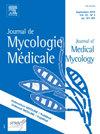Performance of recombinase polymerase amplification-based assay (RPA) for rapid detection of fungal pathogens in clinical samples of patients in Abidjan, Côte d’Ivoire
IF 1.8
4区 医学
Q3 MYCOLOGY
引用次数: 0
Abstract
Background
The diversity of fungal species involved in medical mycology and the increasing rates of resistances make antifungal therapy increasingly challenging. A strategic approach aims to prevent the spread of resistant fungal pathogens and address the prolonged culture time required for fungal identification. The identification of microscopic fungi in biological samples has gained growing interest in molecular biology. The promising isothermal amplification technique can overcome the shortcomings of conventional methods by offering a short reaction time, as well as high specificity and sensitivity.
Objective
This study was initiated to develop a rapid method for identifying fungi from patient biological samples.
Materials.and.Methods
Ninety biological samples were collected from patients and various anatomical sites. The samples were cultured, and DNA extraction was performed on the isolates and biological products. The obtained DNA was used for amplification via RPA (Recombinase Polymerase Amplification).
Results
The results demonstrated varying sensitivity and specificity depending on the type of biological sample, with high sensitivity and specificity for mucosal samples (100 %, respectively), followed by those of invasive mycoses (80 % and 67 %, respectively), and superficial mycoses (72 % sensitivity).
Conclusion
The overall sensitivity and specificity of the RPA method across all sample types were elevated, with 92 % and 100 %, respectively.
重组酶聚合酶扩增法(RPA)快速检测阿比让Côte科特迪瓦患者临床样本中真菌病原体的性能
医学真菌学中真菌种类的多样性和耐药性的增加使得抗真菌治疗越来越具有挑战性。一种战略方法旨在防止耐药真菌病原体的传播,并解决真菌鉴定所需的长时间培养问题。生物样品中微小真菌的鉴定在分子生物学中引起了越来越大的兴趣。等温扩增技术具有反应时间短、特异度高、灵敏度高等优点,克服了传统方法的不足。目的建立一种快速鉴定患者生物标本中真菌的方法。材料和方法从患者和不同解剖部位收集90份生物标本。对样品进行培养,对分离物和生物制品进行DNA提取。获得的DNA通过RPA (Recombinase Polymerase amplification)进行扩增。结果不同生物样品的敏感性和特异性不同,其中粘膜样品的敏感性和特异性较高(分别为100%),其次是侵袭性真菌病(分别为80%和67%),浅表真菌病(分别为72%)。结论RPA法在所有样品类型中的总体敏感性和特异性均有提高,分别为92%和100%。
本文章由计算机程序翻译,如有差异,请以英文原文为准。
求助全文
约1分钟内获得全文
求助全文
来源期刊
CiteScore
5.10
自引率
2.80%
发文量
68
审稿时长
6-12 weeks
期刊介绍:
The Journal de Mycologie Medicale / Journal of Medical Mycology (JMM) publishes in English works dealing with human and animal mycology. The subjects treated are focused in particular on clinical, diagnostic, epidemiological, immunological, medical, pathological, preventive or therapeutic aspects of mycoses. Also covered are basic aspects linked primarily with morphology (electronic and photonic microscopy), physiology, biochemistry, cellular and molecular biology, immunochemistry, genetics, taxonomy or phylogeny of pathogenic or opportunistic fungi and actinomycetes in humans or animals. Studies of natural products showing inhibitory activity against pathogenic fungi cannot be considered without chemical characterization and identification of the compounds responsible for the inhibitory activity.
JMM publishes (guest) editorials, original articles, reviews (and minireviews), case reports, technical notes, letters to the editor and information. Only clinical cases with real originality (new species, new clinical present action, new geographical localization, etc.), and fully documented (identification methods, results, etc.), will be considered.
Under no circumstances does the journal guarantee publication before the editorial board makes its final decision.
The journal is indexed in the main international databases and is accessible worldwide through the ScienceDirect and ClinicalKey platforms.

 求助内容:
求助内容: 应助结果提醒方式:
应助结果提醒方式:


